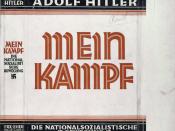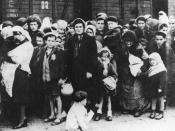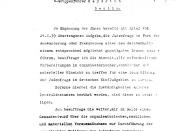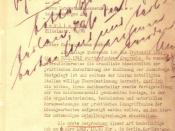The Final Solution Hitler's 'Final Solution to the Jewish Question' was one of the, if not the, most terrible occurrences of the twentieth century. That it happened, that it was on a huge scale, and that Hitler played the major role in bringing it about, are accepted by most historians. The main issue which is in doubt is how the euphemistically named 'Final Solution' came about. Did Hitler always intend to 'exterminate the Jews'? Were all the men who planned and committed the atrocities merely following orders, as wass often claimed in war trials? Did Hitler start out with a concrete, step-by-step plan for the annihilation of Jews, which merely awaited the proper time to be put into action? This is an essentially two-sided debate. The two sides, which Ian Kershaw refers to as 'Intentionalists' and 'Structuralists', have different ideas of the origins of the same event. The 'Intentionalists', looking at Mein Kampf or other sources, such as Hitler's many speeches, see evidence of Hitler's desire for the physical elimination of the Jews, some as early as 1914, others not until the writing of Mein Kampf. The 'Structuralists', on the other hand, look at the haphazard nature of Nazi Jewish policy. In other words, 'Intentionalists' see Nazi anti-semitic policy as developing in stages - discrimination and emigration, deportation - to a pre-planned outcome, genocide. The 'Structuralists', on the contrary, see the progression as unplanned, with one measure only switching to another when the first failed.
One major point of contention between the two interpretations is what Hitler meant in Mein Kampf and many of his speeches. Hitler frequently made use of terms such as the 'elimination' (Ausschaltung) or 'annihilation' (Ausrotung) of Jews. This cannot, however, be taken as conclusive, as the 'Intentionalist' Jäckel admits. Hitler certainly used a lot of rhetoric, and most of the words he uses, such as 'removal' or 'cleaning out', are ambiguous. According to Dawidowicz , such ambiguities were deliberately masked references to killing, understandable to insiders as such but able to be disavowed. Perhaps, but such words could, on the other hand, be meant literally, that Hitler originally wanted merely to deport all the Jews, not to slaughter them.
Probably the most quoted passage in Mein Kampf, however, has few things which are ambiguous: 'If at the beginning of the war and during the war, twelve or fifteen thousand of these Hebrew corruptors of the nation had been put under poison gas ⦠a million orderly worthwhile Germans might have been saved.' To this there is little answer, save to ask why, if this was Hitler's plan, even after the beginning of the war, Jews were not being killed and why they were at first killed by shooting (gas was developed against Russian POWs not Jews).
A second point of contention has to do with Hitler's pre-War encouragement of emigration and eventually deportation of the Jews. Hitler constantly called for the emigration of the Jews, and in 1933 he had a treaty whereby Jews could move to Palestine, and take their belongings. The deprivation of civil rights, especially in the Nüremberg laws, fulfilled Hitler's promise to eliminate 'the legal prerogatives of the Jew' which for Hitler was an important end in itself, but it was also an important means. For Dawidowicz, it is a means towards 'identifying and isolating Jews from non-Jews' This is probably true, but it also was a means of pressuring the Jews to leave.
By 1939, it was clear that emigration was proceeding too slowly and that many Jews would not voluntarily leave. On January 24, Göring ordered Heydrich to organise the emigration or deportation of German Jews In December, 1939, the first ghetto was set up in Poland, and by March 1940, all Polish ghettos had been filled with deportees. No more could be accommodated. In June, 1940, in keeping with the authority granted him by Göring, Heydrich told Foreign Minister Ribbentrop, that the 'overall problem' of the approximate three and a quarter million Jews in German territory 'could no longer be solved through emigration,' and that a 'territorial solution was therefore necessary. It was then that a plan was suggested to deport all Jews to to a Jewish reservation on Madagascar or to a reservation near the Urals after the conquest of Soviet Russia.
The 'Madagascar plan' proved logistically impossible. According to Jäckel, however, 'Hitler had already decided on a much more radical alternative anyway.' This view fits in with Dawidowicz, who said that 'pressure for Jewish emigration was only byplay.' Neither of these views makes sense. If Hitler had always intended to kill every Jew in existence, why would he have sent some to Palestine, others to France, in preparation to move to Madagascar, and allowed others to emigrate to England, America and other places. Deporting people you intend to kill seems counterproductive.
Hitler already had concentration camps for his political enemies, and if he always intended to kill the Jews, why did Hitler deport them instead of concentrating or ghettoising them far sooner than he did? Indeed Dawidowicz cites Göring's post-Kristallnacht interministerial conference of 12 November 1938, where he suggested ghettos as a means of concentrating Jews. If extermination was the final aim, why was this suggestion not followed? Broszat argued that until the collapse of the German offensive in Russia, and consequently of hopes of a Russian 'Jewish reservation', deportation remained Hitler's aim. When the Blitzkrieg failed, however, the Nazi commanders in Poland and Russia found themselves with millions of Jews on their hands, and more coming in from Germany. In the light of the circumstances many leaders took 'local initiatives'. This can be shown partly by the diverse methods employed, originally shooting, then gas.
What is incontestable is that Nazi policy was to exclude the Jews from Germany. How that was to be achieved, however, was for a subtantial period left unclear. This lack of clear objectives, let alone clear instructions, led to many different policies, including boycott, emigration, repressive legislation, 'Aryanisation' (expropriation of property), or deportation, in an attempt to meet the vague goal of removing the Jews. According to Dawidowicz, Hitler's 'apparent indifference to the unregulated pluralism with regard to the Jews ⦠extended only until he was ready to put his war plans into action.'. However, as the diverse plans would have made Hitler's real policy harder to carry out (by dispersing Jews and even depriving them of the property which held them to a certain spot, and thus stop them staying in their own homes, where they could be found), this seems implausible. Also, if all the policy was part of Hitler's grand plan, as other historians have claimed, why was so much of it done so hastily? Key questions in the debate concern the practical realisation of the 'Final Solution' itself, the mass murder first of Russian and Polish, and then of all European Jews. By December, 1941 the extermination of all European Jews had begun. This raises two issues in this debate: first, why, if Hitler had been planning extermination since 1924, he waited so long; second, why specifically he undertook the extermination of the Jews at the same time as he was embroiled in a World War.
Dawidowicz largely ignores the question of why, if Hitler had always intended genocide, did he take so long to start. Her only answer is a vague and unsupported statement that on 30th January, 1939, Hitler's Final Solution entered the stage of practical planning and implementation. This date, only six days after Heydrich was asked to prepare for Jewish emigration, seems premature. It also raises the question of why, if Hitler had planned for two years, were the extermination camps not made ready sooner? One must ask why, if the planning had been done so early, was the Wannsee conference, which co-ordinated arrangements for the 'Final Solution', not held until the 20th January 1942, over a month after Chelmno had become operational, and over nine months since the first shootings of Russian Jews? Haffner's arguments for why Hitler waited are perhaps among the best. According to him, as long as it looked as though Hitler could win quickly in Russia, and then perhaps negotiate a peace with Britain, he did not want to do anything to make a negotiated peace impossible, as mass murder in Western Europe (where England could get reports) would have done. Haffner says that, in December, Hitler 'made his choice between two incompatible aims which he had pursued from the onset - German domination of the world, and the extermination of the Jews.' He then claims that Hitler 'abandoned the former as unattainable.' This is slightly weak, as in 1941 Hitler losing the war was not a foregone conclusion. He could still have won both his aims.
Haffner's second suggested reason, both for why Hitler waited and why he kept the details of his plans secret is that he did not trust the German people. This explanation is quite plausible. Twice, Htiler had tested anti-Jewish feeling: in the April 1933 boycott of Jewish businesses, and on the Reichskristallnacht of 9th and 10th November 1938. The German public had taken part in neither, and the reaction had been negative. Hitler could not trust them to approve of his grand designs.
However, timing was not just a matter of dates. For by the time extermination actually began, Hitler was involved in a War on two fronts. Trains, workers, etc., which were needed for war, were diverted for exermination. From this Jäckel draws the conclusion that extermination of Jews was, to Hitler, as or more important than war versus Russia, and from this, and from other sources, like Hitler's speeches he and Haffner link the war, in Hitler's mind, to Jewish extermination. As evidence, both cite, among other things, Hitler's speech to the Reichstag on 30th January, 1939: 'If international financial Jewry inside and outside of Europe should succeed in thrusting the nations into a World War once again, then the result will not be the Bolshevization of the earth and with it the victory of Jewry. It will be the annihilation of the Jewish race in Europe.' Perhaps in the light of the final qualification we should note Hitler's attempts to send Jews from Europe, but otherwise, if we accept a psychological link for Hitler between the two issues, this is perfectly valid.
Nevertheless, this argument misses or ignores an obvious point. If Hitler was exterminating the Jews during the war, he showed a lack of planning. Surely it would have been better to use their labour in armaments factories (or if they could not be trusted with this, at least to free up Geran workers for armaments) and to kill them after the war. If this was not a viable alternative, it would have been best to get rid of all the 'Jewish saboteurs' in Germany, Poland and other occupied territories before attacking Russia. The fact that they didn't is indicative of lack of planning.
It is possible to explain the irrationality of the timing of Final Solution by questioning the rationality of Hitler himself. However this explanation does not appear to have suggested itself to the Intentionalists I have read, perhaps because it would lessen their emphasis on Hitler as the central planner of the Final Solution.
There is no general agreement as to whether or not the actual killing of Jews was begun with an official 'Führer order,' and even among those who believe that it was, there is no general consensus as to its timing. This is not of particular significance in this debate as there is a general agreement that the extermination of Jews did start somewhere between spring 1941 (the approximate date of the Kommissarbefehl orders, which may or may not have been taken as general extermination orders), and August or September, corresponding to a huge jump in execution figures. This order must, by December (when Chelmno opened) have been extended to a general European order, although whether in the light of Germany's predestined glorious triumph, in vengeance for a faltering Russian campaign or, as Haffner argues, in recognition that it was now or never is, and will almost certainly remain unclear After December, 1941, there is little to discuss on this question. Despite dispute over details, there is a general consensus as to the existence of the 'Final Solution' and as to Hitler's knowledge and approval of genocide, planned or unplanned. From this point on, the 'Final Solution' was fact.
It is impossible fully to understand an event so unprecedentedly horrible and shrouded in secrecy as the Holocaust. We shall probably never know for certain which of the contending interpretations is right, and, as I have tried to show, there are a number of plausible arguments on both sides. There are, however, too many elements in Nazi anti-Jewish policy inconsistent with either each other or with a premeditated final goal, for a purely 'Intentionalist' argument to be plausible. The 'Structuralists', on the other hand, explore a number of complexities ignored by the 'Intentionalists'. The real answer is probably a mixture of the two sides, but 'Structuralism' seems to me a stronger component in that mix.
Notes: The Nazi Dictatorship. Problems and Perspectives of Interpretation, 3rd Edition, Edward Arnold, London, 1993.
'The Structuralist type of approach lays emphasis on the unsystematic and improvised shaping of Nazi "policies" towards the Jews, seeing them as a series of ad hoc responses of a splintered and disorderly government machinery. Although, it is argued, this produced an inevitable spiral of radicalisation, the actual physical extermination of the Jews was not planned in advance, could at no time before 1941 be in any realistic sense envisaged or predicted, and emerged itself as an ad hoc solution to massive and self-imposed administrative problems of the regime.' Ibid., p.82.
Hitler's Weltanschauung, Wesleyan University Press, Connecticut, 1972, p.61.
Op. cit., p. 50.
The War Against the Jews. 1933-1945, Holt, Rinehart and Winston, New York, 1975, 151 and 153.
It should be noted that translation plays a large part in the controversy. In a letter Hitler wrote on September 16, 1919, he talks about his Jewish policy: Antisemitism based purely on emotional grounds will always find its ultimate expression in the form of pogroms [unplanned outbreaks of violence]. A rational antisemitism, however, must lead to the systematic legal fight against and the elimination of the prerogatives of the Jew which he alone possesses in contradstinction to all other aliens living among us. Its ultimate goal,, however, must unalterably be the elimination of the Jews altogether. [cited in Jäckel, op. cit., p.48] This seems fairly unequivocal, until we look at the translation of the same passage by Dawidowicz, [op.cit., p. 153] which replaces 'elimination' with 'removal'. Even where a stronger word is used, like 'extermination', physical killing is not always intended. For example, Hitler spoke of the 'extermination of Germandom in the Austro-Hungarian empire, when all he meant was the process of degermanisation.
Mein Kampf, p. 772, cited in Jäckel, op. cit., p. 60.
See n. 6 above.
Op. cit., p. 159.
See J. Noakes and G. Pridham, eds., Documents on Nazism, 1919-1945, Jonathan Cape, London, 1974, p. 468.
Philippe Burrin, Hitler et les Juifs, Editions du Seuil, Paris, p. 129.
Ian Kershaw, op. cit,. p. 96 Op. cit., p. 61.
Op. cit., .161.
Ibid., p. 160.
Cited in Kershaw, op. cit., p. 85 Op. cit, p.160 The 'Nüremberg laws' are a perfect example of such haste. These laws were drafted in response to pressure from below, and to regulate discrimination already taking place. 'Experts' on the 'Jewish question' began drafting the 'Law for the Protection of German Blood and German Honour' on 13 September, 1935, on menu cards due to lack of drafting paper. The laws were released on 15 September, 1935, two days after the laws were begun. See Documents on Nazism, p. 463.
Op. cit., p. 161.
Sebastian Haffner, The Meaning of Hitler, Harvard University Press, Cambridge, Mass., 1979, p. 142 Ibid., p. 141 Op. cit., pp.61-62.
Cited in Jäckel, op. cit., p. 61; five later speeches by Hitler, citing this earlier one, are mentioned in Haffner, op. cit., p. 131.
For example, in Lithuania in July, the Extermination Squads reported 4239 Jews executed, one hundred and thirty five of whom were women. In August, the figure reached 37,186 killed, most after the middle of the month, and 56,459 in September, including 26,243 women and 15,112 children. [see Philippe Burrin, op. cit., p. 124.] Bibliography: Bauer, Yehuda, A History of the Holocaust, Franklin Watts, New York, 1982.
Burrin, P., Hitler et les Juifs. Genèse d'un génocide, Editions du Seuil, Paris, 1989.
Dawidowicz, L., The War Against the Jews. 1933-1945, Holt, Rinehart and Winston, New York, 1975.
Haffner, S. The Meaning of Hitler, trans. Ewald Osers, Harvard University Press, Cambridge, Massachusetts, 1979.
Jäckel, Eberhard, Hitler's Weltanschauung, trans. Herbert Arnold, Wesleyan University Press, Connecticut, 1972.
Kershaw, Ian, The Nazi Dictatorship. Problems and Perspectives of Interpretation, 3rd Edition, Edward Arnold, London, 1993.
Noakes, J, and Pridham, G., eds. Documents on Nazism, 1919-1945, Jonathan Cape, London, 1974.





